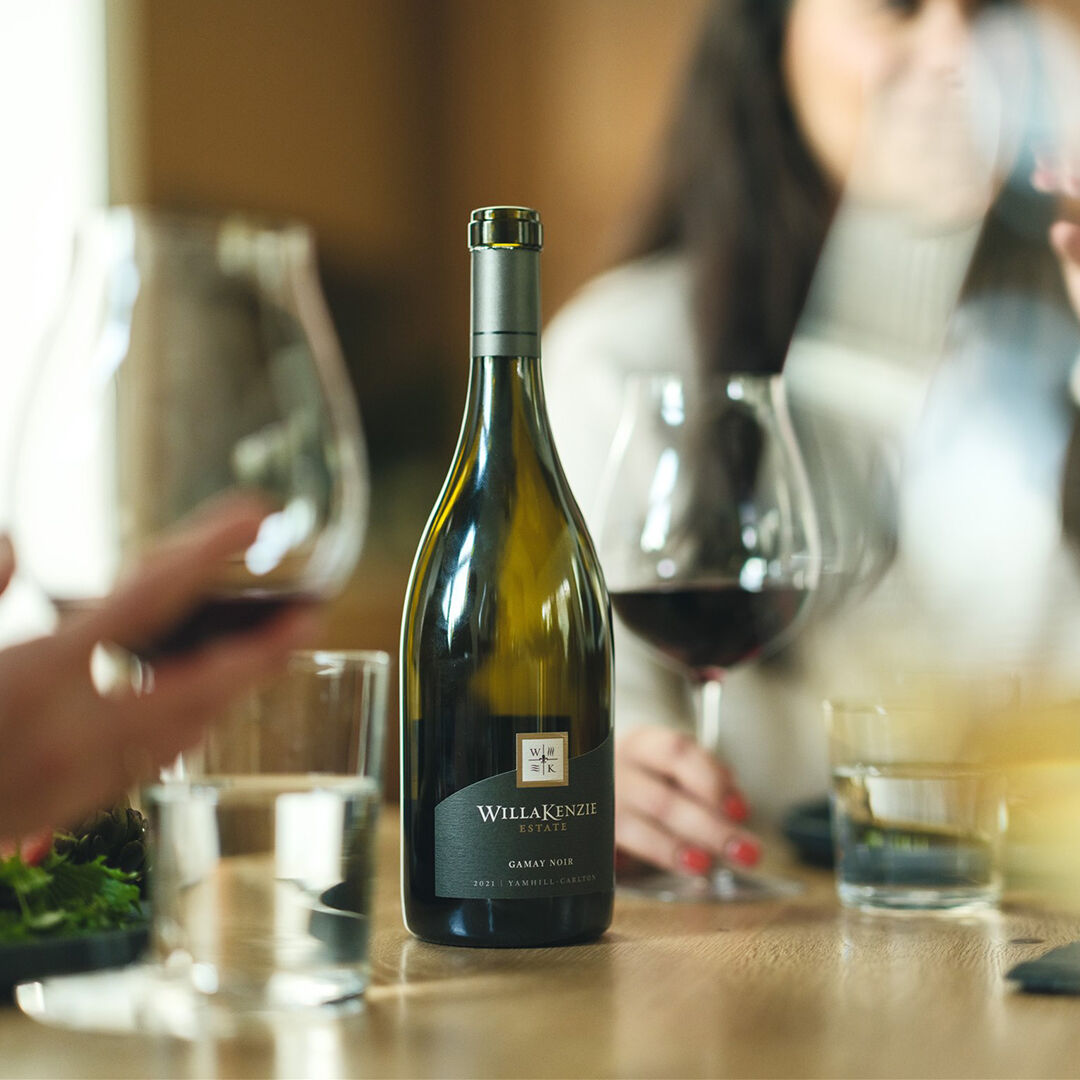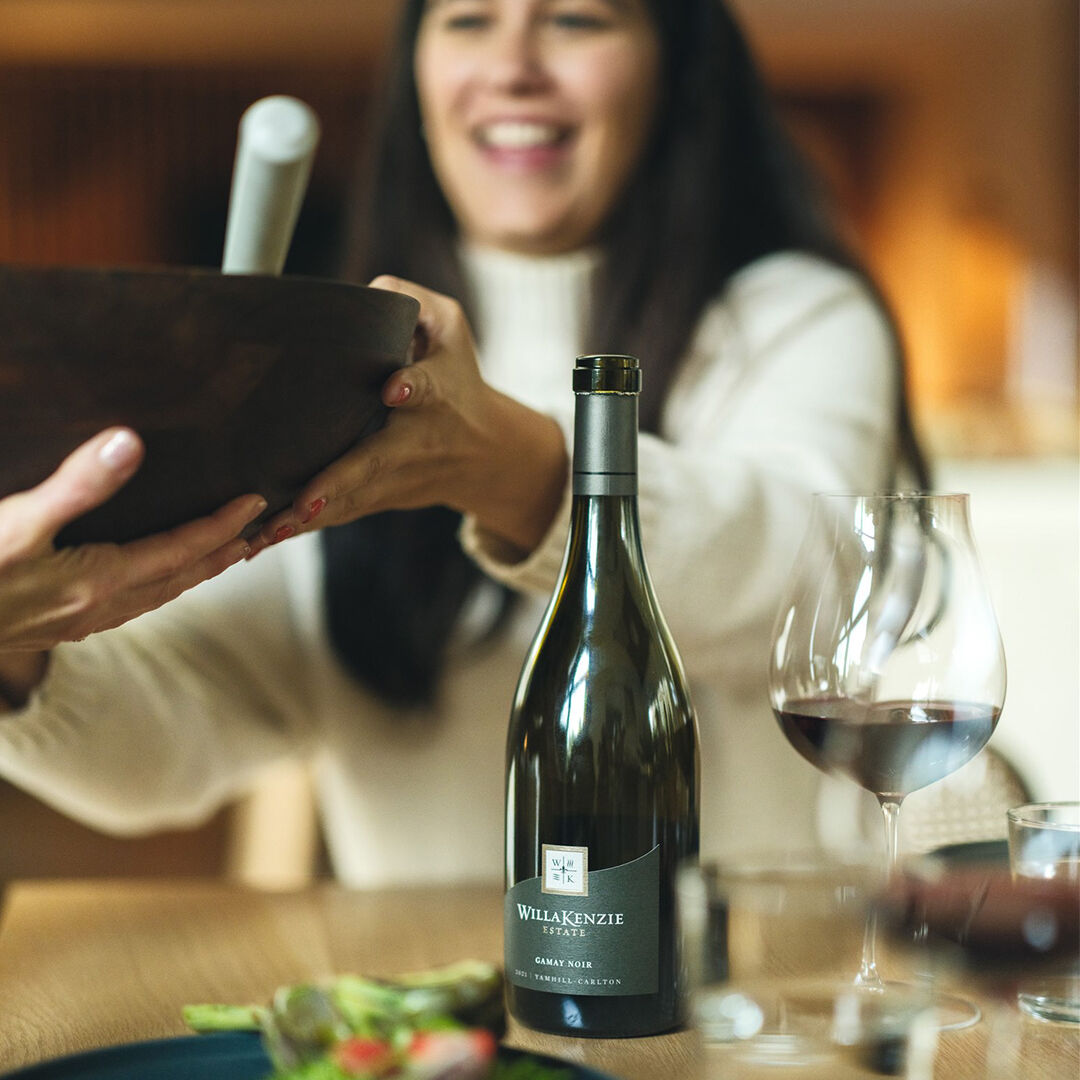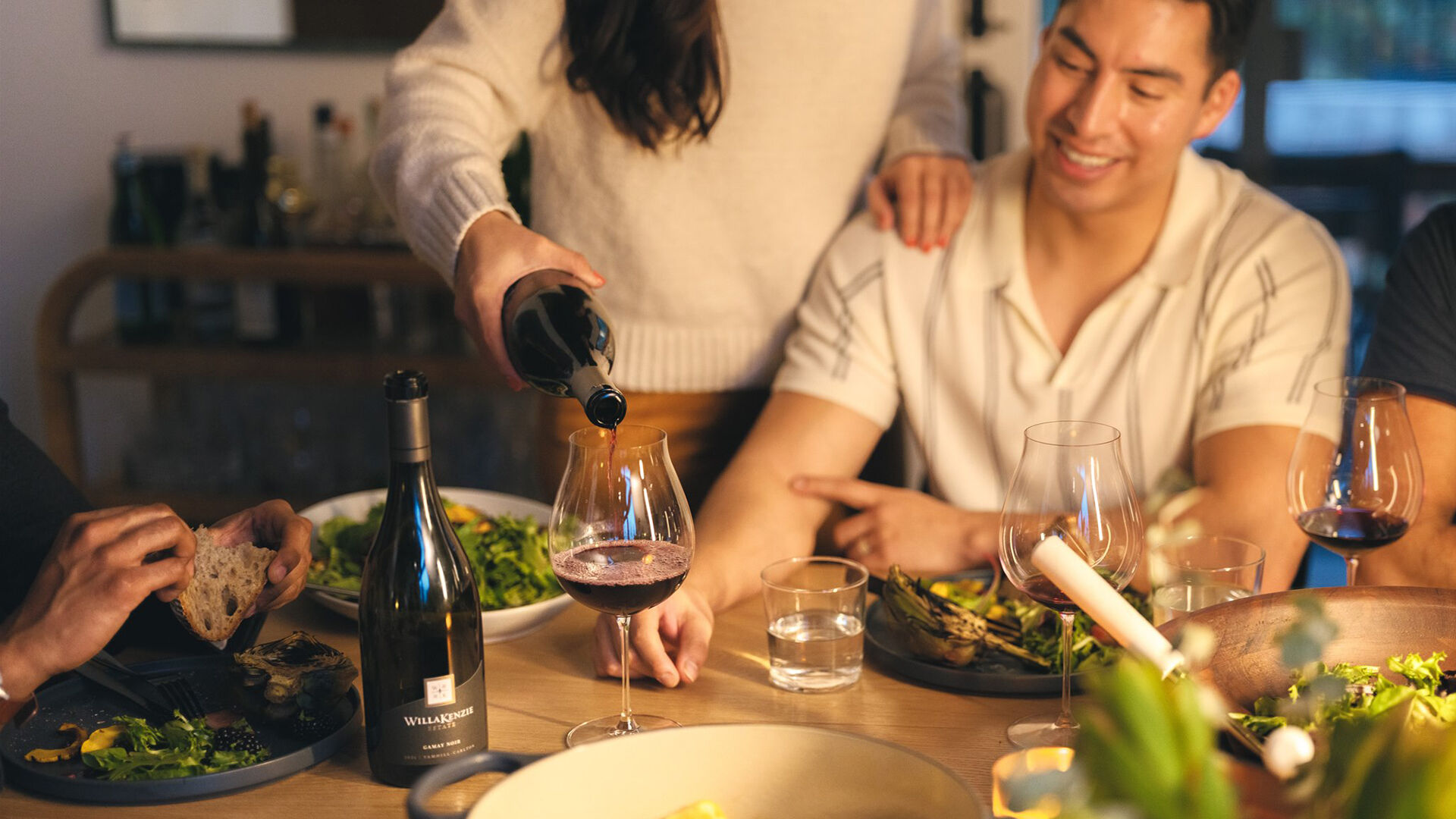Categories
Karen Magner
The Ultimate Guide to Gamay Wine: What it is, History, Pairings, and More
This comprehensive guide delves into everything you need to know about Gamay Noir (typically called “Gamay”). Explore what makes Gamay unique, from its French origins and how it is produced to its diverse styles and characteristics. Whether you’re a seasoned wine enthusiast or a curious beginner, you’re sure to find insights that will enhance your enjoyment of this variety.



What is Gamay Wine?
Gamay (pronounced ga-may) is a red wine crafted from the Gamay Noir grape. Predominantly produced using carbonic maceration, this wine is known for its fresh and fruity character. Light to medium-bodied, it has vibrant acidity and low tannins, making it food-friendly and easy to drink. Gamay is also referred to as Beaujolais, named after the region in France where it is primarily grown. Beaujolais Rosé of Gamay and Beaujolais white wines (made from Chardonnay) are also produced in the region.
The rise in popularity of France’s Beaujolais Nouveau Day brought Gamay into the global spotlight. This harvest celebration, held the week prior to Thanksgiving in the United States, centers on the release of a light-hearted wine made from the current harvest and bottled within two months of picking. In contrast, the Beaujolais-Cru villages offer complex, barrel-aged, and ageworthy expressions of Gamay.
Where Does Gamay Wine Come From?
More than 90 percent of Gamay grows in France’s Beaujolais region. Within France, Gamay also grows in the Mâconnais sub-region of Burgundy, the Savoie, and the Loire. Outside of France, Gamay exists as a pure varietal or as a blend with other grapes in Switzerland, Canada, New Zealand, Italy, California, and Oregon (notably, WillaKenzie Estate!).
Beaujolais is a 35-mile-long, 9-mile-wide strip in southern Burgundy, planted to more than 30,000 acres of vines, 96% of which are Gamay (and the remaining 4% Chardonnay). Nestled between the Massif Central to the west and Saône river to the east, Beaujolais has a cool, continental climate that is perfectly suited to the early ripening Gamay grape.
In some ways, it’s amazing that Gamay survived given its homeland’s humble beginnings. In 1395, the Burgundian duke Philippe the Bold banished Gamay from the Côte d’Or to Beaujolais in the south. Owing to the tenacity of winegrowers willing to cultivate Gamay on 30-degree slopes, at elevations of 1,600 feet or greater, the variety endured. In 1936, Beaujolais earned its first official appellation. In 2018, Beaujolais became the first wine region to earn the UNESCO Global Geopark designation, owing to its geological diversity of more than 300 soil series from 15 parent material types or bedrocks. Today, nearly 78 million bottles of Gamay are produced in the Beaujolais region alone.
Within Beaujolais, 12 appellations exist and fit into one of three separate classifications: Beaujolais, Beaujolais-Villages, and Beaujolais-Cru. The standard Beaujolais—also the primary source for Beaujolais Nouveau—contributes to the majority of the region’s production. The fruit is grown in mostly clay soils on flatter terrain in the south, known as Bas Beaujolais.
In the region’s middle, Beaujolais-Villages comprises 38 villages whose vineyards lie on hillier, granitic and sandy slopes, producing higher-quality Gamay compared to regular Beaujolais.
At the northernmost point, Haut Beaujolais is home to the 10 Beaujolais-Cru villages, each of which has its own AOC. Their wines, known as Cru Beaujolais, rival Burgundian Pinot Noir for a fraction of the price. These villages include St.-Amour, Juliénas, Chénas, Moulin-à-Vent, Fleurie, Chiroubles, Morgon, Régnié, Brouilly, and Côte de Brouilly. The vineyards, perched on steep hills of granitic and schist soils, nurture grapes with complex fruit flavors, enhanced by extensive barrel aging. WillaKenzie Estate Winemaker Erik Kramer crafts our Estate Gamay in a Cru Beaujolais style, which you can read more about below.

What Does Gamay Wine Taste Like?

The carbonic maceration technique used to produce Gamay brings out the variety’s fruity—often, candied—aromas and flavors of cherry, raspberry, black cherry, and strawberry. At times, it can taste peppery or floral. With its low tannins, light to medium body, lively acidity and earthy undertones, Gamay can resemble Pinot Noir. Overall, Gamay exudes easy-drinking charm and versatility, ideal for casual sipping all year long and pairing with a variety of dishes.
Gamay Food Pairings & Recommended Serving Temperature
Gamay can support and enhance a variety of cuisines, including specialties of Lyon – France’s gastronomic capital located near Beaujolais. Here are some delectable pairing suggestions:
· Poultry: Gamay's light body, acidity, and fruit complement the savory flavors of chicken stuffed with Morel mushrooms (a Lyonnais specialty) or your Thanksgiving turkey.
· Charcuterie: Pairing boards featuring pâté and cured meats, like prosciutto and salami, bring out Gamay’s savory and earthy undertones.
· Grilled Seafood: Gamay’s light body and acidity frame the subtle flavors of grilled tuna or shrimp without overwhelming them. The wine’s fruity notes complement this spice-crusted salmon.
· Vegetarian Dishes: Gamay's fruity profile harmonizes with the earthy, umami notes found in vegetarian cuisine, from scalloped potatoes to veggie couscous. Because it has low tannins, Gamay can handle a side like bitter greens. This spaghetti with green veggies, burrata and pistachio pesto looks like a beautiful match for our Estate Gamay Noir!
· Cheeses: Serve Gamay with Brie, aged Gouda, or a roasted Vacherin. The wine's acidity cuts through the creaminess, while its fruit-forward profile complements the cheese's intrinsic flavors.
· Spicy Cuisine: Gamay's fruitiness mitigates the heat in spicy dishes like Thai or Indian cuisine.
Recommended Serving Temperature: Slightly chill your Gamay to about 55° F (about 15 minutes in the refrigerator) before serving. Did we mention that Gamay makes a great chillable red wine in summer?

Innovation in Gamay Wines at WillaKenzie Estate
WillaKenzie Estate, gifted with its diverse terroir, is one of a small handful of producers in Oregon who are able to grow this variety. Our winemaking team uses the Cru Beaujolais style to craft an elegant, finessed wine. The fruit is sourced from the Aliette neighborhood near the peak of our Estate, where cool foggy mornings and sun-drenched afternoons encourage an expression defined by purity and clarity.
What is Carbonic Maceration, and How Does it Influence the Final Wine?
Carbonic maceration is a winemaking technique in which whole grape clusters are placed in a tank filled with carbon dioxide. The grapes absorb the CO2, which triggers an enzymatic reaction, causing the grapes to begin fermenting—without the help of yeast—from the inside out. Eventually, the grape skins split open and transition to traditional fermentation, with the wild yeast on the skins converting the remaining sugar into wine and CO2. Winemakers today use carbonic maceration not just with Gamay but also with fuller-bodied varieties, such as Tannat and Shiraz, to maximize the grape’s fruity aromas and flavors, increase freshness, soften tannins and acidity, lighten color, and potentially reduce alcohol levels.
WillaKenzie's Approach to Gamay Noir Production
The WillaKenzie Estate winemaking team combines carbonic maceration and regular fermentation to create our Estate Gamay Noir. After the grapes are harvested by hand, roughly 60% of the whole clusters undergo carbonic maceration. Subsequently, the juice is pressed off the skins and primary fermentation is completed in a tank with indigenous yeast. The remaining 40% of the grape clusters are destemmed and fermented separately with indigenous yeast. In the style of a Cru Beaujolais, Winemaker Erik Kramer blends these two portions to create the final wine. The carbonic macerated fruit imparts bright, exotic, and wild confectionary notes, while the traditionally fermented fruit adds richness. The final wine ages for seven months in 20% new French oak.
2023 Estate Gamay Noir Wine
The WillaKenzie 2023 Estate Gamay Noir offers lush aromas of boysenberry, mulberry, cocoa powder, and baking spice. The dark fruit profile carries over to a palate framed by electric acidity and sleek, graceful tannins. Only 257 cases produced.
Indulge in Oregon Wine Craftsmanship at WillaKenzie Estate
Now that we hopefully have you thirsting for Gamay, may we pour you a glass? Visit our tasting room, which recently underwent a stunning redesign to reflect the textural beauty of our wines. We look forward to hosting you!
Five Fun Facts About Gamay
1. Gamay Noir, the grape behind France's Beaujolais wine, dates to the 14th century and is now scarcely found outside of France.
2. In Oregon, Gamay Noir makes up less than 1% of the total wine grape production.
3. Beaujolais Nouveau Day started as a way to celebrate the end of harvest in France. Today, the barely fermented wine is released globally at 12:01 a.m. on the third Thursday of November.
4. High-quality Beaujolais is produced by the ten “cru” villages in the Beaujolais region (and by WillaKenzie Estate, of course!).
5. Beaujolais is made with a technique called carbonic maceration, in which whole grape clusters ferment spontaneously in a tank due to their own weight and natural yeast.

